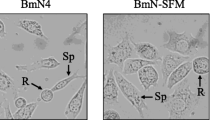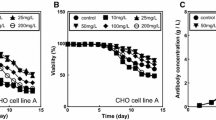Abstract
While the ectopic expression of the anti-apoptoticprotein Bcl-2 has been shown to significantly increaseboth cell viability and antibody production in batchculture, some cell lines are refractory to thesemanipulations. For example, the NS/O and theP3x63Ag8.653 murine myelomas, which express highendogenous levels of the Bcl-2 homologue Bcl-xL, areboth resistant to the anti-apoptotic effect of Bcl-2.This indicates that, in these cells, Bcl-2 and Bcl-xLmay be functionally redundant. In order to define therole which Bcl-xL plays in hybridoma cultures, we usedthe Sp2/0-Ag14 cell line. This murine hybridomaexpresses low levels of Bcl-xL and is highly sensitiveto apoptosis induction by cycloheximide (CHX) and byamino acid depletion. Bcl-xL-transfected Sp2/0-Ag14cells were more resistant than the wild type and theplasmid-containing cells to apoptosis induced by CHXand by glutamine depletion. Moreover, when compared tothe vector-transfected control, Bcl-xL-Sp2/0 cellsexhibited a substantial increase in viability instationary batch culture. Interestingly, Sp2/0-Ag14cells overexpressing Bcl-xL showed a growth behaviourthat was similar to the parent myeloma cell lineP3x63Ag8.653. Our results suggest that Bcl-xLexpression levels are sufficient to account for therelative robustness of some hybridoma cell lines instationary batch cultures.
Similar content being viewed by others
References
Adams JM and Cory S (1998) The Bcl-2 protein family: Arbiters of cell survival. Science 281: 1322–1326.
Ashkenazi A and Dixit VM (1998) Death receptors: signaling and modulation. Science 281: 1305–1308.
Chao DT and Korsmeyer SJ (1998) BCL-2 family: Regulators of cell death. Annu Rev Immunol 16: 395–419.
Chen G, Branton PE, Yang E, Korsmeyer SJ and Shore GC (1996) Adenovirus E1B 19-kDa death suppressor protein interacts with Bax but not with Bad. J Biol Chem 271: 24221–24225.
Chiou SK, Tseng CC, Rao L and White E (1994) Functional complementation of the adenovirus E1B 19-kilodalton protein with Bcl-2 in the inhibition of apoptosis in infected cells. J Virol 68: 6553–6566.
Cotter TG and Al-Rubeai M (1995) Cell death (apoptosis) in cell culture systems. Trends Biotechnol 13: 150–155.
Dickson AJ (1998) Apoptosis regulation and its applications to biotechnology. Trends Biotechnol 16: 339–342.
Fadeel B, Zhivotovsky B and Orrerius S (1999) All along the watchtower: on the regulation of apoptosis regulators. FASEB J 13: 1647–1657.
Fassnacht D, Rossing S, Franek F, Al-Rubeai M and Portner R (1998) Effect of Bcl-2 expression on hybridoma cell growth in serum-supplemented, protein-free and diluted media. Cytotechnology 26: 219–225.
Franek F and Dolnikova J (1991) Nucleosomes occurring in proteinfree hybridoma cell culture. Evidence for programmed cell death. FEBS Lett 284: 285–287.
Franek F, Vomastek T and Dolnikova J (1992). Fragmented DNA and apoptotic bodies document the programmed way of cell death in hybridoma cultures. Cytotechnology 9: 117–123.
Fujita T, Terada S, Fukuoa K, Kitayama A, Ueda H and Suzuki E (1997) Reinforcing apoptosis-resistance of COS and myeloma cells by transfecting with bcl-2 gene. Cytotechnology 25: 25–33.
Gauthier ER, Piché L, Lemieux G and Lemieux R (1996) Role of bcl-xL in the control of apoptosis in murine myeloma cells. Cancer Res 56: 1451–1456.
Green DR and Reed JC (1998) Mitochondria and apoptosis. Science 281: 1309–1312.
Hansen MB, Nielsen SE and Berg K (1989) Re-examination and further development of a precise and rapid dye method for measuring cell growth/cell kill. J Immunol Methods 119: 203–210
Itoh Y, Ueda H and Suzuki E (1995) Overexpression of bcl-2, apoptosis suppressing gene: prolonged viable culture period of hybridoma and enhanced antibody production. Biotechnol Bioeng 48: 118–122.
Mastrangelo AJ and Betenbaugh MJ (1998) Overcoming apoptosis: new methods for improving protein-expression systems. Trends Biotechnol 16: 88–95.
Mastrangelo AJ, Hardwick JM, Zou S and Betenbaugh MJ (2000) Overexpression of Bcl-2 family members enhances survival of mammalian cells in response to various culture insults. Biotechnol Bioeng 67: 555–564.
Mercille S, Jolicoeur P, Gervais C, Paquette D, Mosser DD and Massie B (1999) Dose-dependent reduction of apoptosis in nutrient-limited cultures of NS/0 myeloma cells transfected with the E1B-19K adenoviral gene. Biotechnol Bioeng 63: 516–528.
Mercille S and Massie B (1994) Induction of apoptosis in nutrientdeprived cultures of hybridoma and myeloma cells. Biotechnol Bioeng 44: 1140–1154.
Mosser DD and Massie B (1994) Genetically engineering mammalian cell lines for increased viability and productivity. Biotechnol Adv 12: 253–277.
Murray K, Ang CE, Gull K, Hickman JA and Dickson AJ (1996) NSO myeloma cell death: Influence of Bcl-2 overexpression. Biotechnol Bioeng 51: 298–304.
Nagata S (1996) Apoptosis: Telling the cells their time is up. Current Biology 6: 1241–1243.
Oltvai ZN, Milliman CL and Korsmeyer SJ (1993) Bcl-2 heterodimerizes in vivo with a conserved homolog, Bax, that accelerates programmed cell death. Cell 74: 609–619.
Perreault J and Lemieux R (1993a) Essential role of optimal protein synthesis in preventing the apoptotic death of cultured B cell hybridomas. Cytotechnology 13: 99–105.
Perreault J and Lemieux R (1993b) Rapid apoptotic cell death of Bcell hybridomas in absence of gene expression. J Cellular Physiol 156: 286–293.
Simpson NH, Singh RP, Perani A, Goldenzon C and Al-Rubeai M (1998) In hybridoma cultures, deprivation of any amino acids leads to apoptotic death, which is suppressed by the expression of the bcl-2 gene. Biotechnol Bioeng 59: 90–98.
Singh R, Al-Rubeai M and Emery AN (1996a) Apoptosis: exploiting novel pathways to the improvement of cell culture processes. Genet Eng Biotechnol 16: 227–251.
Singh RP, Al-Rubeai M, Gregory CD and Emery AN (1994) Cell death in bioreactors: a role for apoptosis. Biotechnol Bioeng 44: 720–726.
Singh RP, Emery AN and Al-Rubeai M (1996b) Enhancement of survivability of mammalian cells by overexpression of the 139 apoptosis-suppressor gene bcl-2. Biotechnol Bioeng 52: 166–175.
Smith CA, Williams GT, Kingston R, Jenkinson EJ and Owen JJT (1989) Antibodies to CD3/T-cell receptor complex induce death by apoptosis in immature T cells in thymic cultures. Nature 337: 181–184.
Terada S, Fukuoka K, Fujita T, Komatsu T, Takayama S, Reed JC and Suzuki E (1997) Anti-apoptotic genes, bag-1 and bcl-2, enabled hybridoma cells to survive under treatment for arresting cell cycle. Cytotechnology 25: 17–23.
Yang E, Zha J, Jockel J, Boise LH, Thompson CB and Korsmeyer SJ (1995) Bad, a hetorodimeric partner for Bcl-xL and Bcl-2, displaces Bax and promotes cell death. Cell 80: 285–291.
Author information
Authors and Affiliations
Corresponding author
Rights and permissions
About this article
Cite this article
Charbonneau, J.R., Gauthier, E.R. Prolongation of murine hybridoma cell survival in stationary batch culture by Bcl-xL expression. Cytotechnology 34, 131–139 (2000). https://doi.org/10.1023/A:1008186302600
Issue Date:
DOI: https://doi.org/10.1023/A:1008186302600




